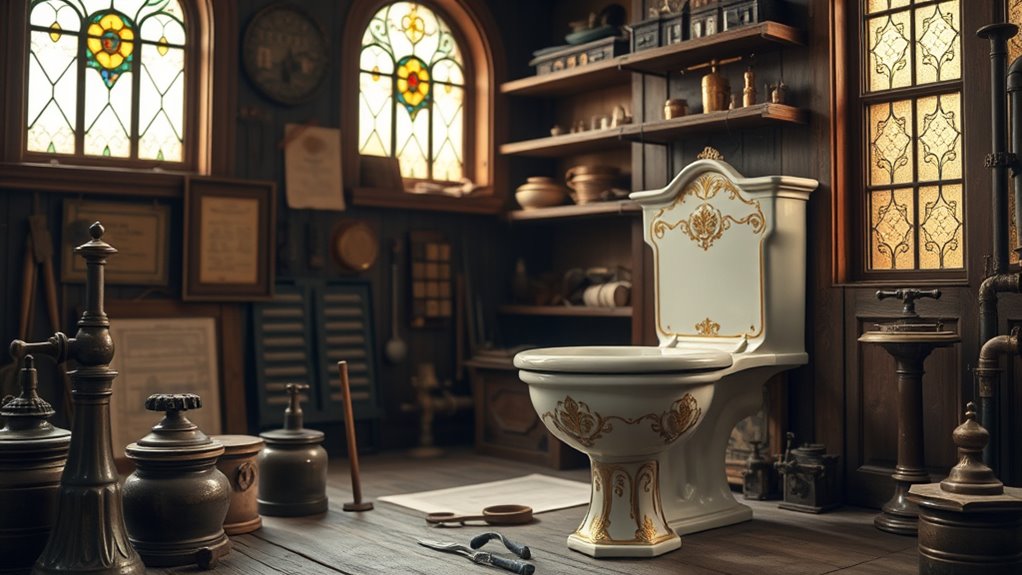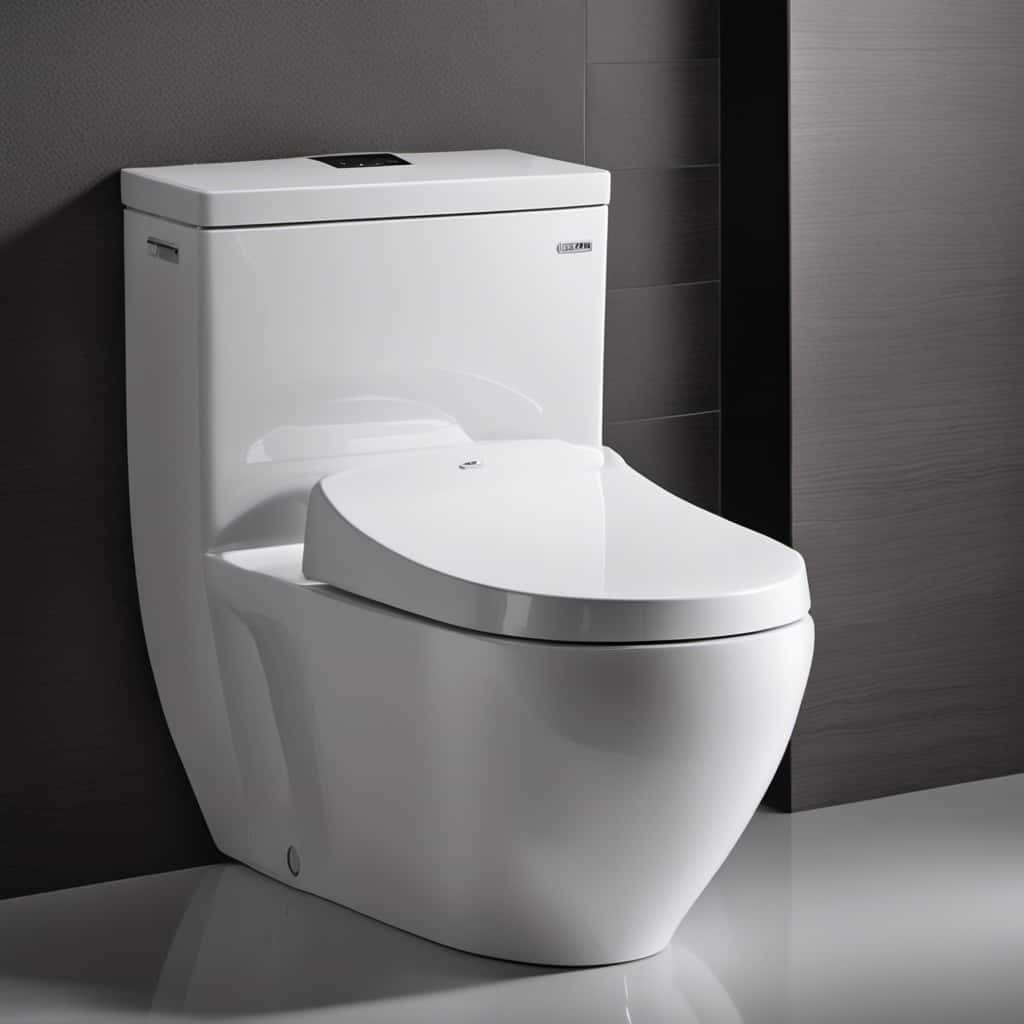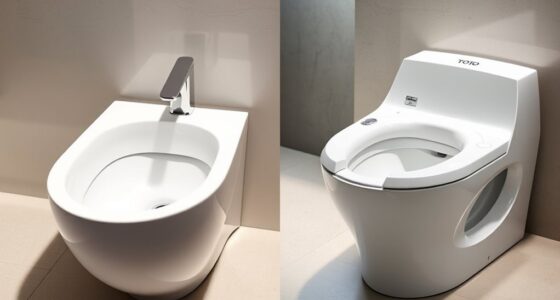The story of Thomas Crapper often appears as him inventing the modern toilet, but that’s a myth. He actually refined, patented, and marketed plumbing innovations that were already being developed in the Victorian era. His true contribution was making these advancements more reliable and popular for homes and public facilities. If you want to uncover how Crapper’s real impact shaped today’s sanitation systems, keep exploring the fascinating history behind this everyday fixture.
Key Takeaways
- Thomas Crapper did not invent the toilet but refined and popularized existing plumbing designs during the Victorian era.
- His name became synonymous with toilets due to effective marketing, although he held patents mainly for improvements.
- The development of modern toilets was a collaborative effort involving many inventors, not solely Crapper.
- Crapper’s contributions helped make advanced plumbing fixtures more reliable and accessible in homes and public facilities.
- Myths often overstate Crapper’s role; his legacy lies in perfecting and promoting sanitation innovations, not inventing them.

Have you ever wondered who truly revolutionized the modern toilet? The answer isn’t as straightforward as you might think. While Thomas Crapper is often credited with inventing the toilet, his real contribution lies more in refining and popularizing plumbing innovations during the Victorian era. Crapper’s name became synonymous with toilet design largely because of his skillful marketing and improvements to the existing technology, rather than being the original inventor. To understand his role, you need to look at the broader context of Victorian engineering, which was marked by significant advances in sanitation and plumbing. During this period, engineers and inventors sought to improve hygiene and public health by developing more effective waste removal systems. Crapper’s contributions fit into this narrative as he helped perfect and promote these innovations, making them more accessible and reliable. Victorian engineering played a central role in transforming bathroom fixtures from basic devices into sophisticated plumbing systems, with innovations like the ballcock valve and the siphon flush, which allowed for more efficient and hygienic waste removal, being key milestones. Crapper’s expertise in manufacturing high-quality plumbing fixtures meant that these innovations could be produced at scale, ensuring that more homes and public facilities could benefit from improved sanitation. His company became renowned for its durable and reliable toilets, which incorporated these advances. Although he did not invent the flush toilet, Crapper’s craftsmanship and business acumen helped popularize the modern design, leading to the widespread adoption we see today. Many myths surround the history of the toilet, and Thomas Crapper’s name often gets exaggerated or misplaced in the story. It’s true that he held several patents and manufactured toilet components, but he built his reputation on perfecting existing designs rather than creating something entirely new. His skill was in refining and marketing these plumbing innovations, making them more practical and appealing to the public. This is where his legacy becomes intertwined with Victorian engineering—his ability to leverage the technological advancements of his time and bring them into homes and businesses. His marketing savvy helped elevate the toilet from a utilitarian device to a fixture of modern comfort and hygiene. The development of the toilet was a collective effort by many inventors and engineers over centuries, with innovations built upon previous engineering advancements. Crapper’s role was pivotal in the context of Victorian engineering, but he wasn’t the sole inventor. His real achievement was in advancing and popularizing plumbing innovations, ensuring they became standard features in modern sanitation. So, next time you flush, remember that the story behind the modern toilet is a complex tale of innovation, refinement, and engineering excellence—much of which was shaped during the Victorian era, with Crapper playing a *fundamental*, though often misunderstood, part.
Frequently Asked Questions
Did Thomas Crapper Invent the Modern Flushing Toilet?
You might think Thomas Crapper invented the modern flushing toilet, but that’s not entirely true. While he popularized improved toilet design and advanced plumbing technology in the late 19th century, many innovations came before him. Crapper’s contributions helped refine the mechanics, making toilets more efficient and reliable. So, he didn’t invent the toilet, but he certainly played a key role in its development, shaping modern plumbing technology as we know it today.
Are All Toilets Called “Crappers” Because of Thomas Crapper?
While not all toilets are called “crappers,” many folks associate the term with Thomas Crapper’s legacy. You might think it’s a direct nod to him, but “crapper” became slang over time, often used humorously or disparagingly. Toilet terminology evolved, and Crapper’s name became linked to toilets, though he didn’t invent the modern one. His name’s now part of the playful language surrounding bathroom fixtures.
What Other Innovations Did Thomas Crapper Develop?
You might wonder about Thomas Crapper’s other contributions. He didn’t invent the toilet, but he considerably advanced plumbing technology with sanitary innovations like improved siphon mechanisms and ballcock valves. His company popularized these plumbing advancements, making bathrooms more hygienic and efficient. Crapper’s work helped shape modern sanitation systems, leading to better public health. So, while not the sole inventor, his innovations played a crucial role in plumbing advancements.
Was Thomas Crapper Involved in Plumbing Beyond Toilets?
Think of Thomas Crapper as a plumbing pioneer who extended his talents beyond just toilets. You’ll find his influence in Victorian innovations, including improved ballcock valves and other plumbing fixtures. His work helped modernize historical plumbing systems, making them more efficient and reliable. So, yes, Crapper’s involvement went well beyond toilets, shaping the evolution of plumbing technology and leaving a lasting mark on Victorian-era innovations.
How Accurate Are the Myths Surrounding Thomas Crapper’S Contributions?
You’re curious about how accurate the myths are surrounding Thomas Crapper’s contributions. While he’s often credited with inventing the toilet, historical accuracy shows he improved existing designs rather than creating the invention itself. Myth debunking reveals many stories are exaggerated or false. Crapper’s real impact was in popularizing and improving plumbing technology, but he didn’t invent the toilet. Recognizing these facts helps you see the true history behind his legacy.
Conclusion
So, as you now know, Thomas Crapper didn’t invent the toilet, but he certainly helped improve it and boost its popularity. The myth that he invented the flush toilet has spread like wildfire, but the truth is more nuanced. Think of the toilet’s history as a tapestry woven with many threads—Crapper’s contributions are just one vibrant strand in that story. Now, you can appreciate the real story behind this everyday marvel, clear and true.










